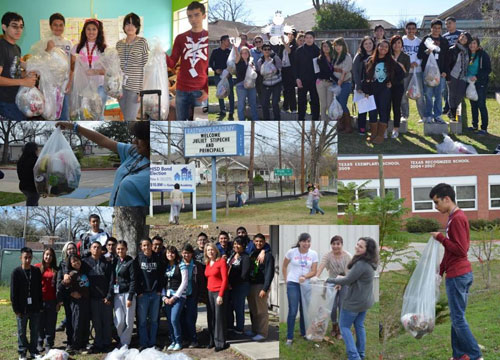Energy and Sustainability
Page Navigation
Eco-Schools USA
-
About the Program
In 2008, NWF was designated as the U.S. host for Eco-Schools, an internationally acclaimed Green Schools program that is helping 900,000 educators in 53 countries advance sustainability and environmental stewardship in their schools, while advancing student learning in Science, Technology, Engineering, and Math (STEM).Eco-Schools USA is a holistic program that strives to make environmental awareness and action an intrinsic part of the culture of a school, creating Eco-Action teams that include students, teachers, administrators, non-teaching staff, and parents, as well as the local community. Students participating in the Eco-Schools USA program partake in a 7-Step project -based framework that includes undertaking a thorough assessment of their energy and water usage, waste production, school grounds, and other aspects of the school community. The school Eco-Action team then develops and implements an action plan to improve conditions on one or more fronts. NWF developed a robust web resource for Eco-Schools USA http://www.nwf.org/Eco-Schools-USA.aspx and launched the U.S. program in late 2009. The program now has 2,600 registered Eco-Schools across the U.S. Eastwood Academy - Consumption and Waste Pathway
Eastwood Academy - Consumption and Waste PathwayPathways to Sustainability
You will choose which pathway or pathways to take on. Most schools tackle just one or two at a time. Use the results of your Environmental Audit to set realistic targets and concentrate on areas that are most relevant to your school.
Please note: The Energy Pathway must be addressed by every school applying for a Silver or Green Flag award.
Many of the Pathways overlap or are closely related to each other. Energy, for example, is connected to Climate Change, and Transportation can be linked to Green Hour. You may find that by making progress in one area, you are taking steps toward improving your performance in another.

Biodiversity
Investigating and increasing biodiversity at school and beyond
A wide diversity of species - animals, plants, and other living things - is the key to a healthy, functioning ecosystem on many scales, from the school grounds to the whole planet.
Climate Change
Incorporating climate change education into curriculum
Schools are joining the movement to solve this urgent environmental issue. They are reducing their "carbon footprints," and in the process, developing science, math, technology and social science skills.
Consumption and Waste
Reducing, reusing, and recycling
A school can reduce its environmental impact by analyzing the full life cycle of the products it uses. Trimming consumption, reducing packaging and transport distance, and recycling as many items as possible all translate into smaller amounts of garbage being hauled away.
Energy
Addressing energy conservation
Schools are the largest energy consumers in many municipalities. But up to 30 percent of that energy is used inefficiently or unnecessarily. Schools can significantly cut energy use, resulting in financial savings and reduced environmental impact.
Healthy Living
Promoting outdoor time, physical activity and other aspects of a healthy lifestyle
Time spent outdoors, physically active, and engaged in unstructured play is perhaps the best possible prescription to ensure a lifetime of good health.
Healthy Schools
Addressing issues that impact human health in the school building and grounds
Eliminating toxic and hazardous materials, while maximizing elements that promote health, will improve the learning environment for students and staff.
School Grounds
Developing "green" grounds
Research has demonstrated that in all discipline areas, students who are given the opportunity to directly engage in outdoor education and experiential learning have been able to significantly increase their capacity for learning.
Sustainable Food
Improving nutrition and food sustainability at school
Food choices have a big impact on both health and the environment. A campaign focused on food sustainability can help you make nutritious, fresh, local and whole foods a part of the culture of your school and community.
Transportation
Addressing school transportation
The Eco-Schools USA program aims to raise awareness of sustainable solutions - transportation that reduces fuel consumption, pollution and car use. Every school can change its travel footprint.
Water
Addressing water conservation
Basic water efficiency programs can reduce a school's water use by 30 percent or more. The Eco-Schools USA program can help schools improve irrigation methods, reduce water runoff, consume fresh water more efficiently, and reuse water to a greater extent.Project Based 7-Steps
Eco-Schools USA uses a program of Seven Steps that involves a wide diversity of individuals from the school community - with students playing a primary role in the process.
It is important that you have made progress on each of these Seven Steps before applying for one of the three Eco-Schools USA awards. Award criteria are provided for each of the Seven Steps. The type of award you apply for will depend upon how thoroughly you have accomplished each step's criteria. If your school has had great success and wants to share how you implemented one or all of the Seven Steps, why not share it with everyone on our Eco-Schools USA Facebook page? You'll need to be registered as an Eco-School to access this page, so register now!
- Establish an Eco-Action Team
- Perform an Environmental Review / Audit
- Develop an Eco-Action Plan
- Monitor and Evaluate Progress
- Link to Educational Curriculum
- Involve the Entire School and Larger Community
- Create an "Eco-Code," or a Mission Statement

